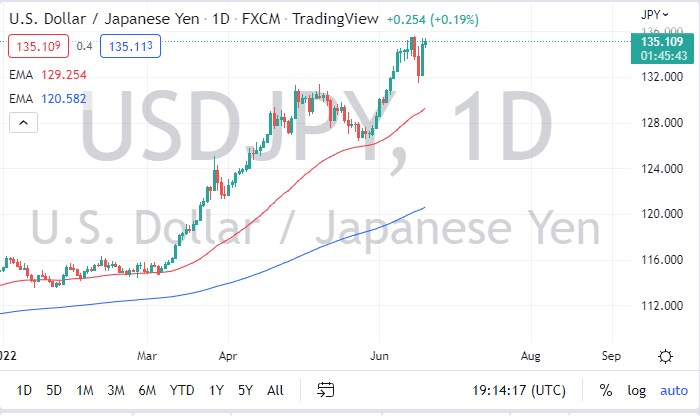[ad_1]
The US dollar has rallied a bit against the Japanese yen during the trading session on Monday, but it should be noted that it was Juneteenth in the United States, so liquidity may have been a bit of an issue. Regardless, we have seen another attempt to break above the ¥135.50 level, and eventually, it looks as if we will do so.
It’s worth noting that the Friday candlestick was extraordinarily bullish, and of course, the Bank of Japan decided to reiterate its pledge to drive interest rates down. As long that’s going to be the case, it remains the only major central bank involved in quantitative easing, meaning that the Japanese yen is going to get absolutely eviscerated. You can see this in multiple currency pairs, not just this one. However, it’s worth noting that the US dollar is the benchmark on which all currencies are measured, so this shows you that not only will this pair continue to look strong, but so will many other ones such as the GBP/JPY, CHF/JPY, and so on.
The ¥132 level should now offer a significant amount of support, so I think pullbacks of that area will be looked at as value. In fact, that’s how I think most people will be looking at this currency pair, one that you should be buying on the dips. The market breaking above the ¥135.50 level opens up the possibility of another rally to reach the ¥137.50 level. After that, the 140 and level is almost certainly going to be a potential destination.
On the downside, we would need to break through the ¥126 level before sellers would start to convince me that they are taking over. The only thing that tells me when this is possible will be when the Bank of Japan finally starts to let rates rise, or the Federal Reserve pivots to a different monetary policy regime. Until that changes, I just do not see a situation where we have a significant selloff, even if we do have a major “risk-off move” in the financial markets. (It should be said that if we do get one of those moves, other pairs such as GBP/JPY might get pounded.) “Steady as she goes” will more likely than not be the way this market behaves over the next several months.

[ad_2]